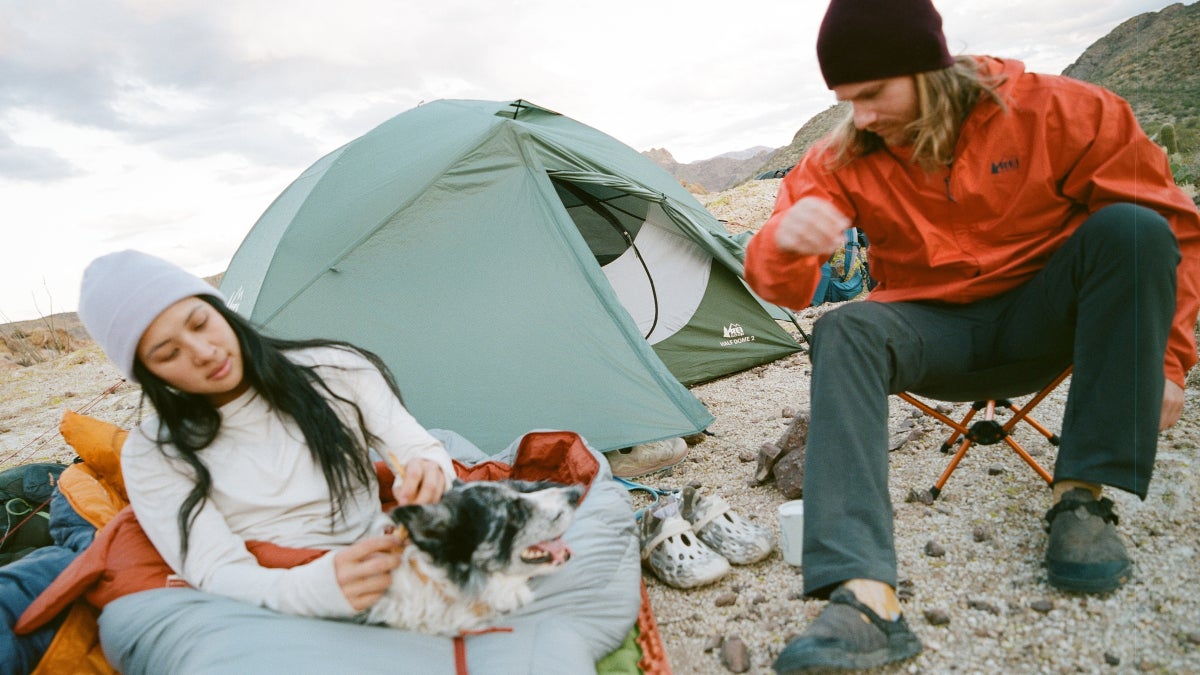
Will Dunn owes his life—and maybe his marriage—to his REI Co-op Half Dome tent.
“The tent was a gift from my now-in-laws before we were in-laws,” he says. “It was my first backpacking tent, and it got us through some pretty delightful hikes—and some pretty harrowing ones.” On one trip, Dunn and his now-spouse were backpacking in Utah’s Canyonlands when a windstorm swept in out of nowhere.
“When it hit us, it hit hard—there were rocks and sticks beating down on the sides of the tent, and we didn’t know when it would end…I sure was happy to have that shelter.”
Dunn’s love letter to his Half Dome is one of thousands. After all, when a tent has been around since 1980—and is built to last through decades of use—it should be no surprise that it has racked up a serious fan club among REI members. And in this case, the Half Dome didn’t just exist for 45 years—thanks to member feedback it remained at the forward edge of shelter design for its category. It still is. That’s not surprising considering that when the tent first debuted in 1980, it revolutionized backpacking for a whole generation of hikers.
The Origins of a Legend
If you wanted to buy a tent back in the late ’70s, your options were pretty limited. You had your heavy synthetic dome tents, flimsy A-frame pup tents, and the old-school canvas numbers your local scouting troop probably lugged around on character-building expeditions. You could choose between a lightweight design and a livable one. Very few brands were building shelters that ticked both boxes—that is, until REI decided to reinvent the tent back in 1979.
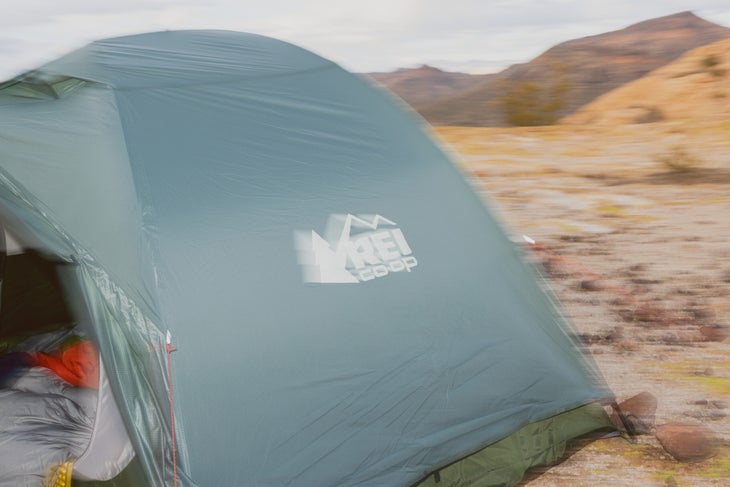
The goal: straighter walls and more livability, all in a lightweight, weatherproof package. Ambitious? Yes. But the team tackled the challenge the same way it did with any new gear project. It polled REI members, gathered feedback, and set to work creating something that really answered the needs of the hiking community.
After a few iterations, the REI design team drew up a cross-pole design with a single entryway. The vertical walls made it easy to organize gear, get dressed, and play cards without bumping nylon. That first tent, released in 1980 and dubbed the Half Dome, was already a game changer. Then David Mydans got ahold of it.
Mydans was a backpacker and climbing bum who got his start at Chouinard Equipment before REI brought him on as a product designer in 1988. He was famous for spending hours on the cutting room floor, sewing up prototypes and tearing them apart, creating gear piece by piece the old-fashioned way.
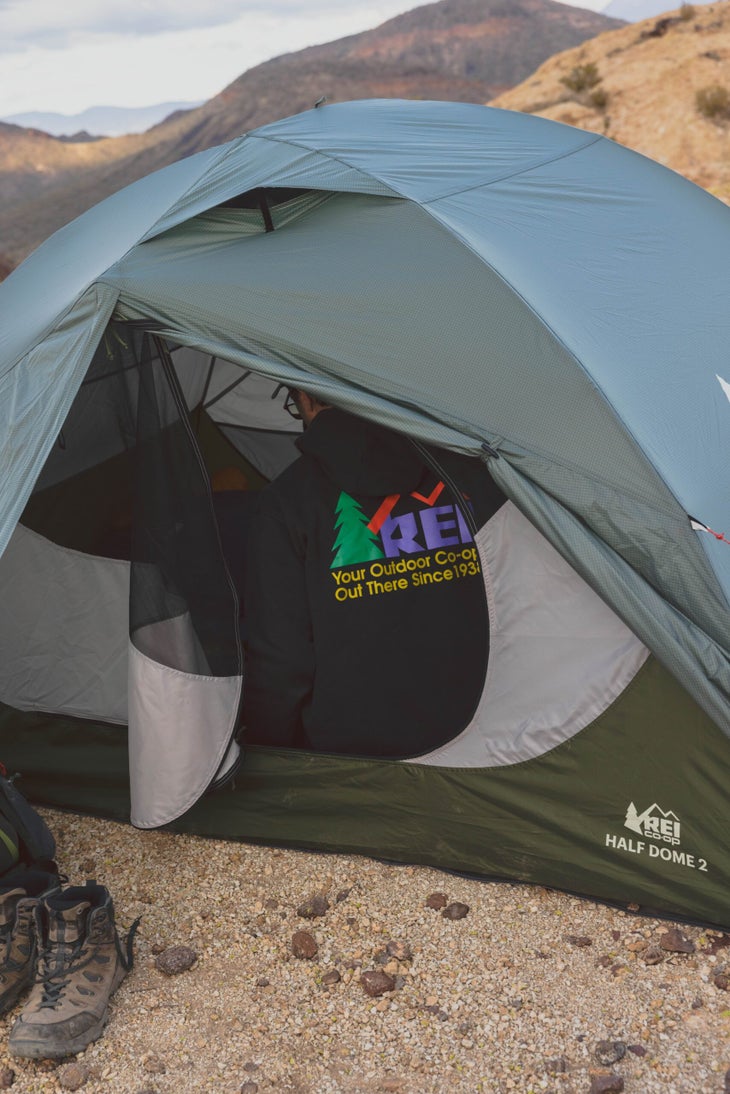
“Product design at REI is still very hands-on, but he was really passionate about it,” says David Crumrine, REI’s current gear design lead. When he started thinking about tent design, Mydans knew he was tired of crawling over his backpacking partners to get to his sleeping bag. He also knew REI Co-op members wanted more livability. REI’s ethos has always been to let member feedback drive innovation, and the Half Dome’s progression owes a lot to that philosophy. But for years, further improvements to the tent’s livability proved elusive. Then, around 2000, Mydans had an epiphany.
“He realized he could create a tent with two doors and two vestibules,” Dunn says. (Since that fateful Canyonlands trip so many years ago, Dunn has become REI’s staff historian and archivist.) After months of tinkering, Mydans turned his epiphany into a prototype: a two-door tent that was comfortable, lightweight, and easy to set up. He dubbed it the Half Dome 2.
Wind Testing on Highway 410
Of course, comfort and convenience weren’t the only essential criteria. If this thing was going to work for hardcore backpackers like Mydans, it also needed to be protective.
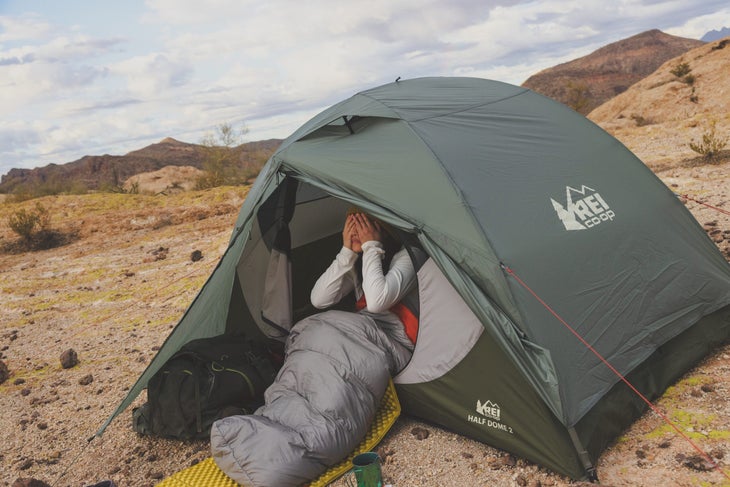
Enter wind-resistance testing 1.0. Back then, product quality and safety standards hadn’t really been established yet. REI often had to create its own to make sure new gear was up to snuff. To test wind resistance, REI fashioned a DIY “laboratory”: an employee’s green pickup truck with a giant wooden platform bolted onto it. Whenever the gear team had a new tent to test, they’d lash it to the platform and drive down a stretch of Highway 410 at 65 mph. A passenger would observe the tent and take diligent notes while the walls flapped thunderously in the wind.
“The testing was actually pretty scientific for the setup they had. They’d test a tent with the door closed, door open, guyed out, not guyed out—you name it,” Dunn says. REI did this from the mid-1970s all the way up until 1993. (The iconic green pickup is now retired; in the ’90s, the co-op switched to wind tunnel analysis. Today, it relies more on computer modeling and in-depth materials testing.)
Awards and Innovation
When the two-door Half Dome 2 launched in 2001, campers quickly fell in love with it. Then, Backpacker Magazine put the Half Dome on the map, awarding the tent a coveted Editors’ Choice Award after two staffers survived a blizzard in it in 2002.
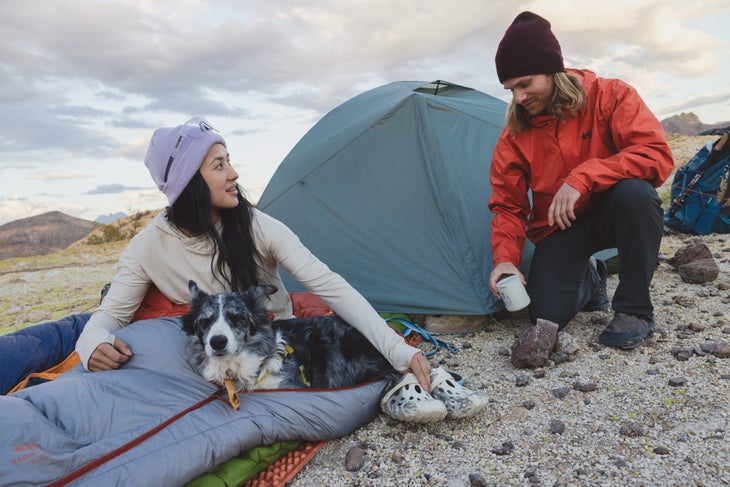
Backpacker also gave the tent an Editors’ Choice Gold Award in 2010. That’s about the time Mydans introduced a new dual hub design that vastly improved the tent’s interior space and livability. (Again, this was a piece of member feedback the gear team took to heart and brought to life.)
Later, the tent got inducted into the Backpacker Gear Hall of Fame and earned Outside Magazine’s Gear of the Year Award. For the editors, nominating it felt like a no-brainer.
“The Half Dome…set a new standard in livability and affordability for a two-person tent,” Backpacker then-editor-in-chief Dennis Lewon said at the time.
But the story doesn’t end there. Over the years, REI kept pushing the envelope. As with its other products, the co-op leveraged new materials and modern technology, finding ways to do more with less weight. Ultimately, designers were able to dramatically expand the Half Dome’s interior space without making it any heavier. The tent became the centerpiece of REI’s Traverse camping line. The fan club only grew.
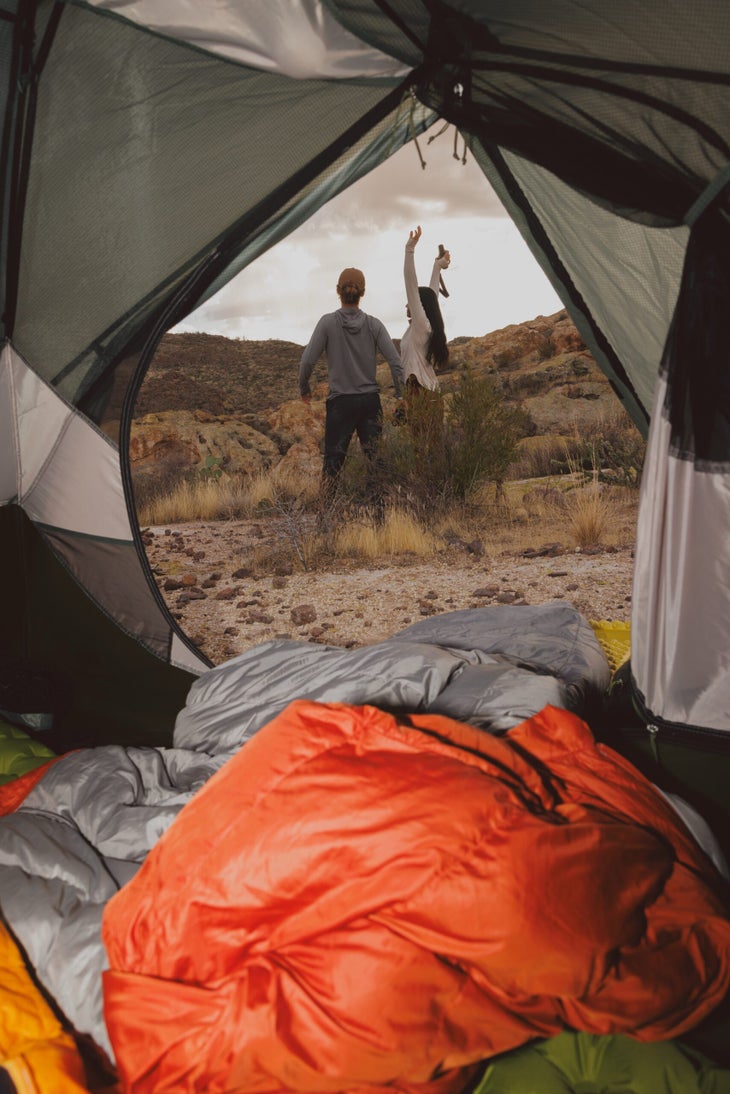
“The Half Dome is the bestselling tent at REI by a large margin,” says Rick Meade, a senior product manager and the brand’s former tent buyer. “We call it the Goldilocks of tents. It’s like your all-wheel-drive SUV—it does everything well, and it’s your trusted companion for all your adventures.”
A New Take on a Timeless Classic
Now, REI is once again relaunching its fan-favorite Half Dome, once again with member-requested updates.
“We did a complete nationwide study a few years back where we went to all the major regions of the U.S., getting out with co-op members in the field and doing interviews,” Crumrine says. “I remember being with a member in their house and just filling up their living room setting up their new Half Dome tent. We’ve done that kind of thing with other products over the years, and we always learn so much through that cooperative research.”
The new tent doesn’t just leverage those recent takeaways—it also stands on the shoulders of 45 years of member inputs and feedback. The result: an all-new Half Dome 2, Half Dome 2 Plus, and Half Dome 3.
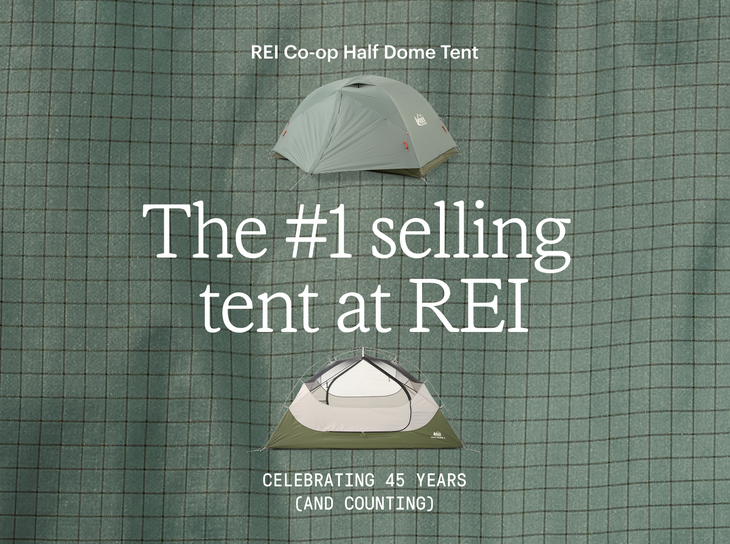
The new tents boast best-in-class comfort, more interior volume, and better weather protection than ever before. All the tent’s outer coatings now have nonfluorinated durable water-repellent (DWR) that helps moisture bead up on the surface, and the rainfly material is more durable thanks to an all-new ripstop reinforcement. And like all REI gear, it’s Climate Label Certified and backed by the co-op’s 100% satisfaction guarantee. In sum: It’s a tent by the people, for the people.
“What I really love about the Half Dome tent is its intersection with design and community,” Dunn says. “It meets those community needs. It’s everybody’s tent.”
Give Back Bonus
REI Co-op is teaming up with the National Parks Conservation Association to defend America’s favorite places. Your Half Dome tent purchase helps power this partnership. From March 25 through April 30, REI will donate 20% of proceeds from full-price Half Dome tent sales to the National Parks Conservation Association. Since 1919, the nonpartisan, nonprofit organization has been the leading voice in safeguarding our national parks.
Half Dome 2 Tent with Footprint Half Dome 3 Tent with Footprint
REI Co-op is a consumer cooperative that exists to inspire and equip everyone to get outside. Everything it makes is created with the mindset and community of a co-op. From the backyard to base camp, REI’s products are designed to be best in class for the great outdoors and the greater good.
The post The Goldilocks Tent That Changed It All, REI’s Iconic Half Dome Turns 45 appeared first on Outside Online.















